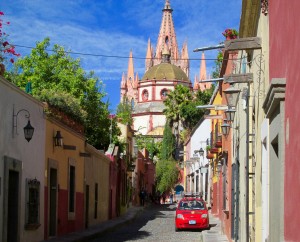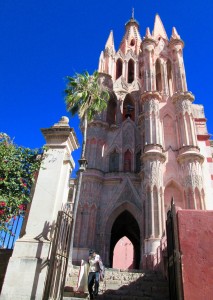Two thousand years before the birth of Christ, I learned just this week, a civilization by the name of Olmecs flourished in south-central Mexico. We know of their achievements – their artwork, their system of writing, their calendar, their ballgames – because they left an enduring record.
I learned about the Olmecs – the first Mesoamerican civilization, which laid foundations for the civilizations that followed – when I attended a viewing of the excellent documentary, “A History of Mexico,” produced by Murray Kamelhar, at the Biblioteca Publica (public library) here in San Miguel de Allende, Mexico, on Wednesday.
Sitting there in the small, rough-old-stone-walled theater of the Biblioteca, built, by the way, nearly three hundred years ago as a community house for poor, single, widowed, or abandoned women, I was awestruck by the newness of all that I was learning. The grand sweep of Mexico’s rich and proud history — filled (as most countries’ histories are) with victories and defeats, courage and corruption, pride and pathos – was essentially new to me. If this history was ever taught in my New Jersey public elementary school, I must have been absent that day.
San Miguel de Allende, a UNESCO World Heritage city, may be well over four hundred years old, but it’s all new to me now. Its bumpy, old, cobblestone streets are still new to my feet. Its Spanish-colonial architecture, dating from the 17th century, is new to my eyes. On my daily walks to and from the center of the city, where the breathtaking Parroquia church’s spires reach up and into Heaven itself, I try to take it all in. But every day’s exploration teaches me something new.


On my walk home from the film at the Biblioteca the other day, my feet got tired. I had walked, oh, maybe four or five miles already that day, and I felt I couldn’t go another step. So I waited at the bus stop in front of the Hotel Real de Minas for the bus that would take me a block away from mi casa – the orange bus, Ruta #7. The public transport system here in San Miguel is excellent; the buses cost only 5 pesos (about 30 cents US) and are surprisingly frequent. There’s never a long wait for the one you’re waiting for.
But that day I waited and waited. Twenty minutes turned to thirty, then thirty-five. What, I wondered, was the hold-up? Then I saw it: a funeral procession, slowly approaching on foot, filling the roadway with slow-moving mourners, the vanguard holding the wooden casket aloft. The procession was at least a half-block long and about eight people wide, and it seemed oblivious to the fact that it was blocking all of the traffic behind it on one of the main arteries out of el centro where the bus I was waiting for was most likely stuck. There were musicians in the crowd of mourners, playing trumpets and guitars. Music filled the street.
This, I surmised, is an old tradition. That such respect for the dead should take precedence over the living was new to me. Road rage be damned.
When the funeral procession finally, slowly, turned a corner and my #7 bus pulled up, I paid my 5 pesos and hopped on. But we didn’t get far. On Cinco de Mayo, about a half mile from my stop, we encountered a street party being set up in celebration of Three Kings Day, an event even more important to the children here than Christmas.
The road was blocked. The young bus driver stopped and conferred with a policeman standing on the sidewalk, then announced in Spanish, “Everybody out.” (I could translate this by the passengers’ body language, since everyone quietly, without arguing or grumbling, got off the bus, including me.) No one seemed to be inconvenienced by this children’s fiesta-in-the-making. So we all had to walk the rest of the way home. On sore feet. So what? (New attitude.)
I’ve observed that most of the gringos here in San Miguel are, like me, older people, retirees and escapees from the U.S. rat race. (My humorous friend Ed in Taos calls San Miguel “God’s waiting room.”) But I personally take great comfort in the fact that the city itself, and the ancient civilizations Mexico is mother to, are a whole lot older than we are. And they still endure.
Yet – and here’s the fun part – so much is new to me here: New sights, new sounds, new tastes, new smells (fragrances waft from bakeries, laundries, flower stands, and [my personal favorite] the after-shave worn by dashing young men), new language…. I’m convinced none of this will ever get old for me.
